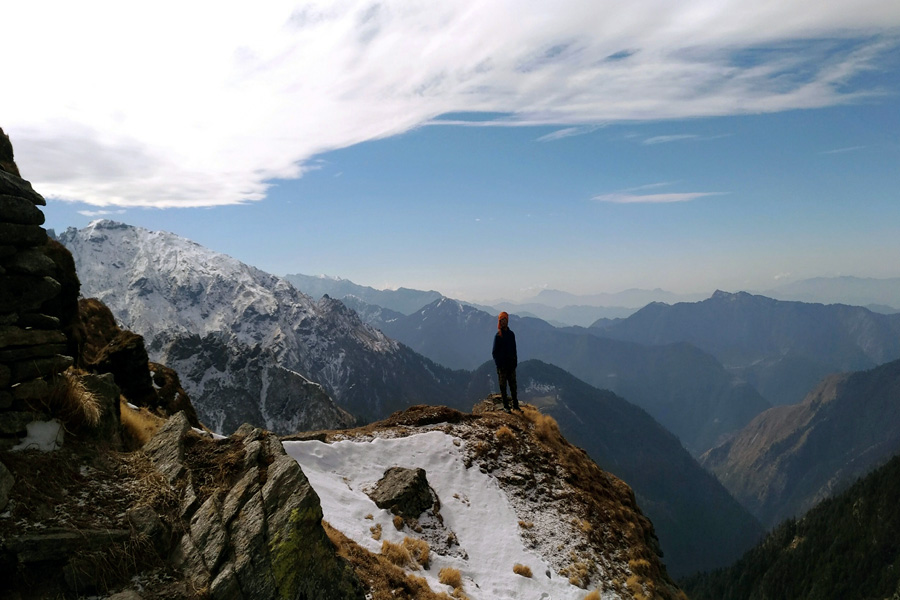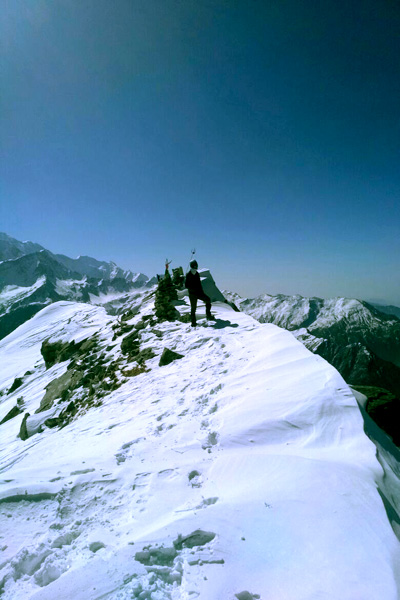Kuari Pass Trek: A Himalayan Journey into Serenity and Splendor
As an avid trekker who’s fallen in love with the Himalayas over and over again, the Kuari Pass Trek stands out as a mesmerizing blend of adventure, serenity, and nature’s grandeur. Situated in the Garhwal region of Uttarakhand, this trek takes you through some of the most pristine and untouched locales of the Indian Himalayas. Whether you’re an experienced trekker or a beginner with a thirst for adventure, the Kuari Pass offers something unique to every soul that ventures into its embrace.



The Beauty of Kuari Pass: A Glimpse into Nature’s Masterpiece
Imagine walking through a trail where every step offers a new view, more stunning than the last. The Kuari Pass trek immerses you in a world where nature’s beauty is untamed and raw, allowing you to witness the symphony of life unfolding across varied landscapes. From thick, ancient oak and rhododendron forests that seem almost magical in their silence, to sprawling high-altitude meadows (locally known as bugyals), the diversity is spellbinding.
The true highlight of the trek, of course, is reaching the Kuari Pass itself, perched at 12,516 feet. The feeling of standing there, enveloped by the sight of towering Himalayan peaks stretching as far as the eye can see, is indescribable. Mount Nanda Devi, India’s second-highest peak, rises majestically in the distance, while Kamet, Dronagiri, Trishul, and the Hathi Ghoda peaks make for a celestial panorama that will etch itself into your heart forever.
The Enchanting Trek Route: Nature’s Playground
The journey begins from Joshimath, a town steeped in spirituality and gateway to several Himalayan treks. From here, the trail takes you through charming villages and terraced fields, giving you a glimpse into the rustic lifestyle of the Garhwali people. As you climb higher, the views become even more spectacular, especially as you enter lush forests teeming with life.
One of the most magical parts of the trek is the passage through the Guling and Khullara campsites. Surrounded by towering peaks, these campsites offer serenity that only the Himalayas can provide. The sound of the wind rustling through the trees, the gurgle of distant streams, and the soft call of Himalayan birds are all that accompany you here.
As you move towards the summit, the trail opens up into expansive meadows. These meadows, dotted with wildflowers in spring and covered in snow during winter, are straight out of a dream. And just as you think it can’t get any better, the view of the snow-clad peaks greets you at every turn, making the effort worthwhile.


Peaks Visible During the Trek: A Feast for the Eyes
One of the most remarkable features of the Kuari Pass trek is the panoramic display of Himalayan giants that accompany you along the trail. The Nanda Devi Massif steals the show, standing tall at 25,643 feet and dominating the skyline. On clear days, you can also catch glimpses of Mana Peak, Hathi Parvat, Ghori Parvat, and Neelkanth, each of them forming a part of this mighty Himalayan range.
As you ascend higher, the peaks seem to rise with you, their snow-capped summits glistening under the sunlight or turning golden during the sunset. The feeling of insignificance when surrounded by such mighty creations of nature is humbling. For those in search of spiritual or meditative experiences, these vistas offer moments of profound peace.



Pristine Locale and Serenity: A Trek into Tranquility
There’s something about the Himalayas that offers more than just physical challenges—it’s about reconnecting with nature, and in many ways, with yourself. The Kuari Pass trek gives you the space to breathe, away from the rush and noise of everyday life. The forests, rich with towering oaks and rhododendrons, have an almost mystical air about them, as though they’ve witnessed centuries of history unfold. There’s a silence here that isn’t just an absence of noise—it’s the presence of peace.
The meadows of Khullara and the solitude of Tali lake offer perfect spots for reflection, where the serenity of the surroundings allows you to lose yourself in thought—or simply marvel at the natural beauty.

Why Kuari Pass Trek? The Perfect Trek for All Levels
The Kuari Pass trek is one of those rare treks that strikes the perfect balance between adventure and accessibility. If you’re a seasoned trekker, the stunning landscapes, challenging ascents, and rewarding views will keep you hooked. And if you’re relatively new to trekking, the well-marked trail and moderate difficulty level make it an ideal introduction to the Himalayas.
For those wondering why they should choose Kuari Pass over other treks, the answer lies in its diversity. This trek takes you through an array of different terrains, from dense forests to alpine meadows to snow-laden paths, all within a few days. And the fact that it offers panoramic views of some of India’s highest peaks without requiring technical mountaineering skills makes it all the more appealing.
Difficulty Level: Moderate Yet Rewarding
The Kuari Pass trek is classified as moderate, making it suitable for both beginners and experienced trekkers. The trail is well-defined, but there are certain steep ascents, especially on the summit day. However, the altitude isn’t extreme compared to some other Himalayan treks, and the gradual acclimatization as you ascend makes it a safe trek for most people
The distances covered each day are manageable, usually ranging from 5 to 10 km, allowing for a comfortable pace. That said, you should still be prepared for cold weather, especially during the winter months, and ensure you’re physically fit enough to handle a few days of walking at high altitudes.


A Journey Into the Heart of the Himalayas
The Kuari Pass trek is more than just a trail leading to a high-altitude pass—it’s a journey into the very heart of the Himalayas. It’s where nature reigns supreme, where the mountains hold stories that have been told for centuries, and where every step brings you closer to both adventure and peace.
For anyone craving an unforgettable trekking experience, whether for the love of nature, the thrill of adventure, or the peace that only mountains can offer, Kuari Pass is the answer. It’s a trek that stays with you long after you’ve left its serene trails behind, a memory carved into the soul, just like the peaks that tower above you.
Kuari Pass Winter Trek
Trek Information
● Location: Garhwal Himalayas, Uttarakhand
● Maximum Altitude: 3,871 meters
● Duration: 05 Nights / 06 Days (Ex. Rishikesh)
● Approximate Trekking Distance: 30 km
● Grade: Easy to Moderate
● Accommodation: 03 nights in tents & 02 nights in hotels
Winter Kuari Pass Trek Itinerary
Day 1: Rishikesh to Joshimath
Your journey begins with an early morning departure from Rishikesh, covering
approximately 260 kilometers to Joshimath. The scenic drive takes around 8 to 9
hours, passing through some of Uttarakhand's most famous confluences, including
Devprayag (where the Bhagirathi and Alaknanda rivers meet), Srinagar,
Rudraprayag (confluence of Mandakini and Alaknanda rivers), and Karnprayag
(confluence of Pindar and Alaknanda rivers). Joshimath, situated at an altitude of
2,100 meters, is also known as Jyotirmath and serves as the winter seat of Lord
Badri.
● Accommodation: Overnight stay in a hotel or guesthouse in Joshimath.
● Meals: Tea and Dinner.
Day 2: Joshimath to Guling via Dakh and Tugasi
After breakfast, you will drive 8 kilometers to Dakh, where your trek begins. The
trek covers 5 kilometers and takes you through Tugasi Village, where you’ll witness
traditional mountain life, including the locals' self-sustaining practices. The trail
continues through walnut and pine forests before opening up to the expansive
meadows of Guling, offering breathtaking views of the Garhwal range, including
peaks like Mt. Dornagiri and Mt. Hanuman. Upon arrival, you’ll have a hot lunch at
the camp, followed by dinner. In the evening, there’s an option to hike to Khuwala
Viewpoint for a spectacular sunset.
● Accommodation: Overnight stay at Guling Camp.
● Meals: Breakfast, Hot Lunch at the camp, and Dinner.
Day 3: Guling to Tali
Your trek today covers 6 kilometers and takes approximately 4 to 5 hours. The trail
leads you through rhododendrons and oak forests, gradually ascending to Tali,
which sits at an altitude of 3,290 meters. Tali offers sweeping views of the
surrounding peaks, making it an ideal spot for nature lovers and photographers.
● Accommodation: Overnight stay at Tali Camp.
● Meals: Breakfast, Packed Lunch on the way, and Dinner.
Day 4: Tali to Kuari Pass and Return to Guling via Kholara
This is the most anticipated day of the trek, as you’ll reach the Kuari Pass, standing
at 3,791 meters. The total trekking distance for the day is 10 kilometers, taking
around 6 to 7 hours. The ascent to the pass is steep initially but becomes more
gradual as you approach the top. The pass offers a 360-degree panoramic view of
the majestic peaks of the Garhwal Himalayas, including Mt. Chaukhamba,
Neelkhanth, Kamet, Mana, and many others. After cherising the views and enjoying
a packed lunch, you’ll trek back down to Guling Camp for the night. Tea, coffee,
and snacks will be available upon your return, followed by dinner. A campfire will
be arranged for the evening.
● Accommodation: Overnight stay at Guling Camp.
● Meals: Breakfast, Packed Lunch on the trek, and Dinner.
Day 5: Guling to Joshimath with an Evening Visit to Auli
After breakfast, you’ll trek 2 kilometers downhill to the roadhead, followed by an
8-kilometer drive back to Joshimath. The descent offers more opportunities to
soak in the stunning scenery of the region. In the afternoon, you’ll have the option
to visit Auli, a popular ski destination, to enjoy the views of Mt. Nanda Devi and
other peaks.
● Accommodation: Overnight stay in a hotel or guesthouse in Joshimath.
● Meals: Breakfast and Dinner.
Day 6: Joshimath to Rishikesh
Your trek concludes today with a return journey to Rishikesh, covering 260
kilometers over 8 to 9 hours. The drive will take you through some of the
lesser-explored yet exceptionally scenic areas of Uttarakhand. Expect to arrive in
Rishikesh by late afternoon or early evening, where the trek officially ends.
● Accommodation: No accommodation provided as the trek ends in
Rishikesh.
● Meals: Breakfast.
Things to Carry:
● Footwear: High-ankle trekking shoes with good grip, trekking pole or stick.
● Clothing: Woolen and fleece clothes, synthetic or waterproof track pants,
rain-proof jackets, wind-proof jackets, and thermal innerwear.
● Accessories: Sunglasses, waterproof gloves.
● Personal Care: Moisturizer, sunscreen lotion, personal medicine kit.
